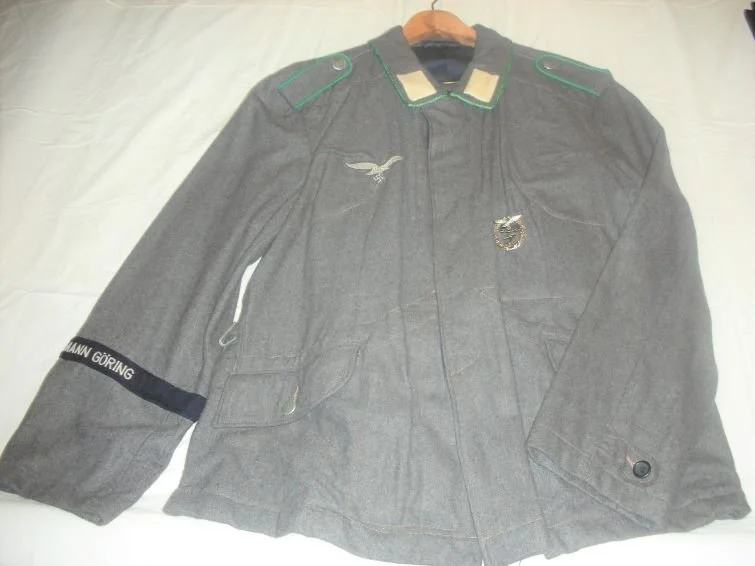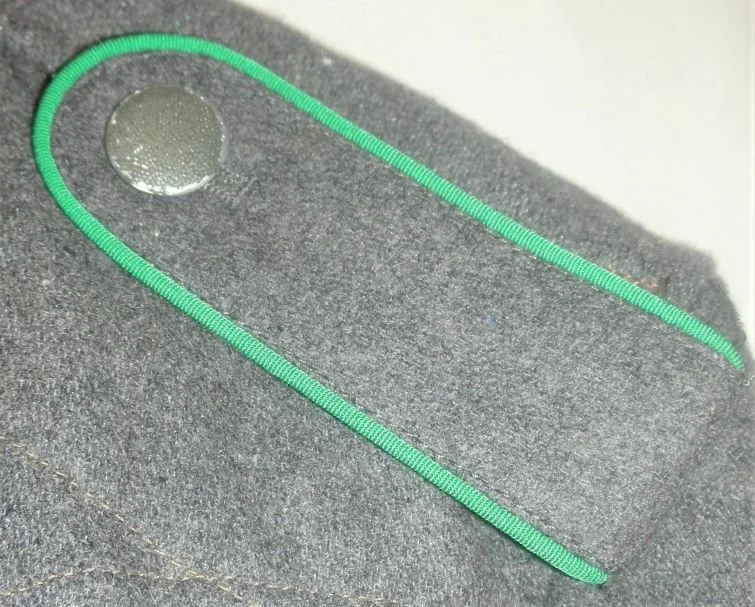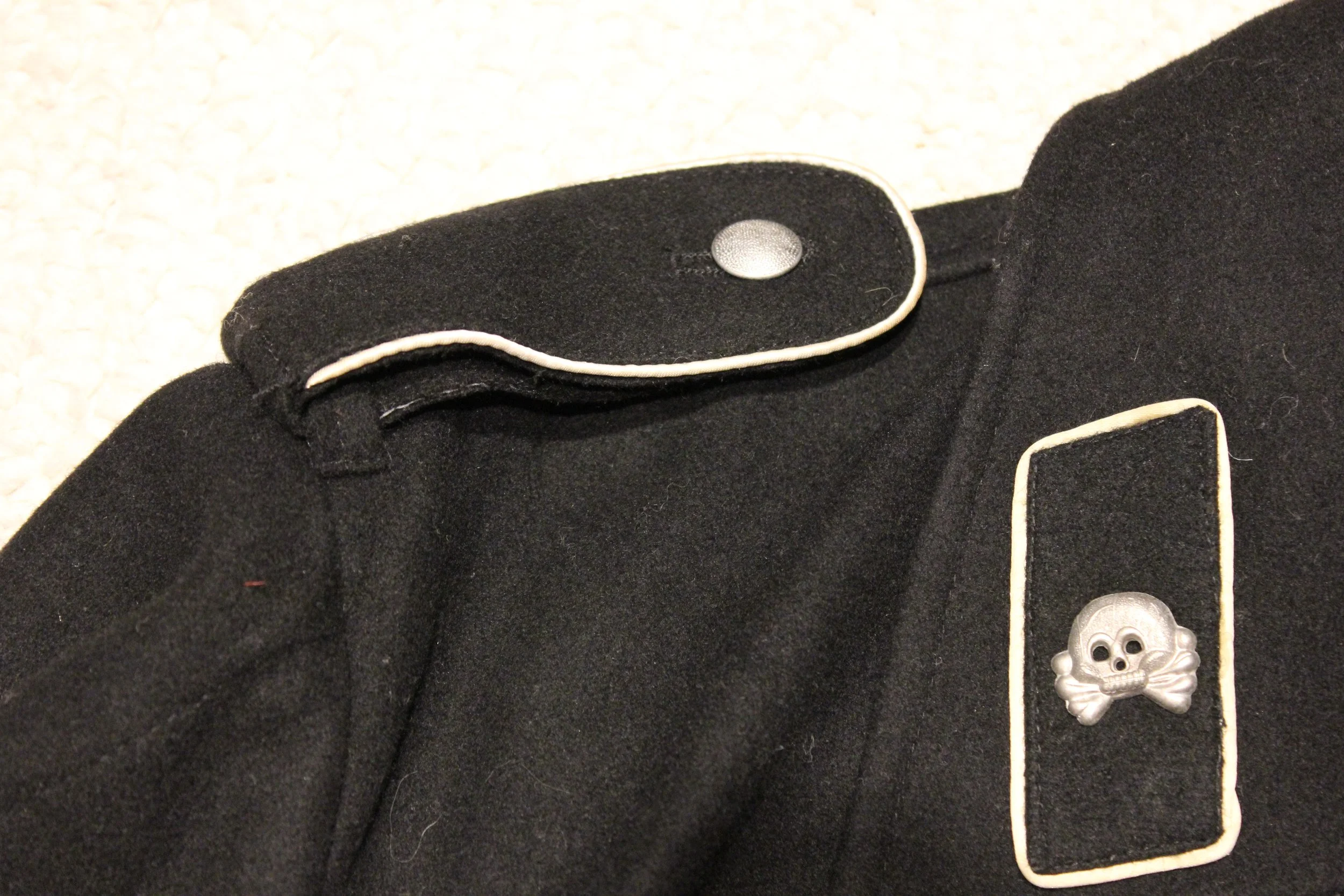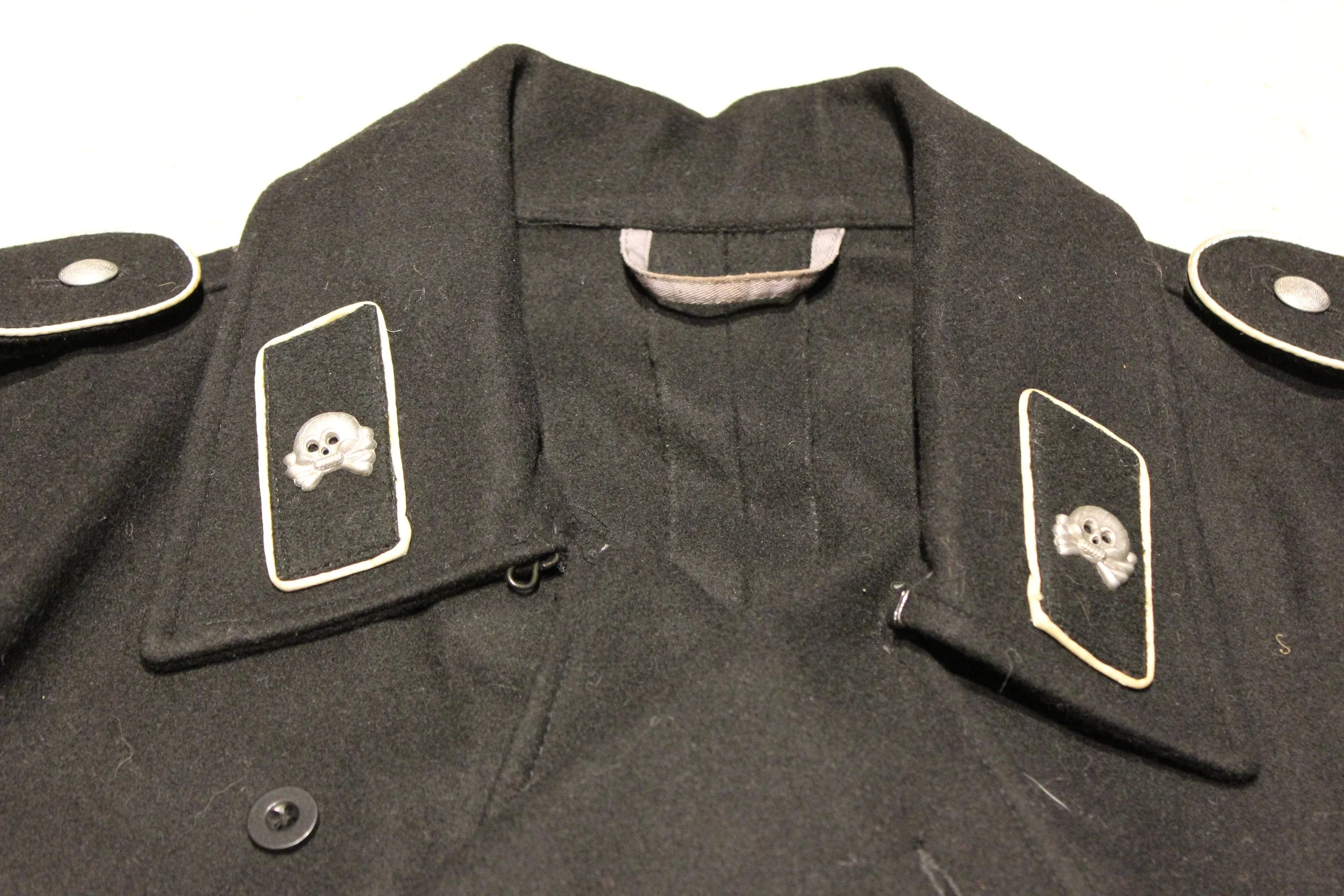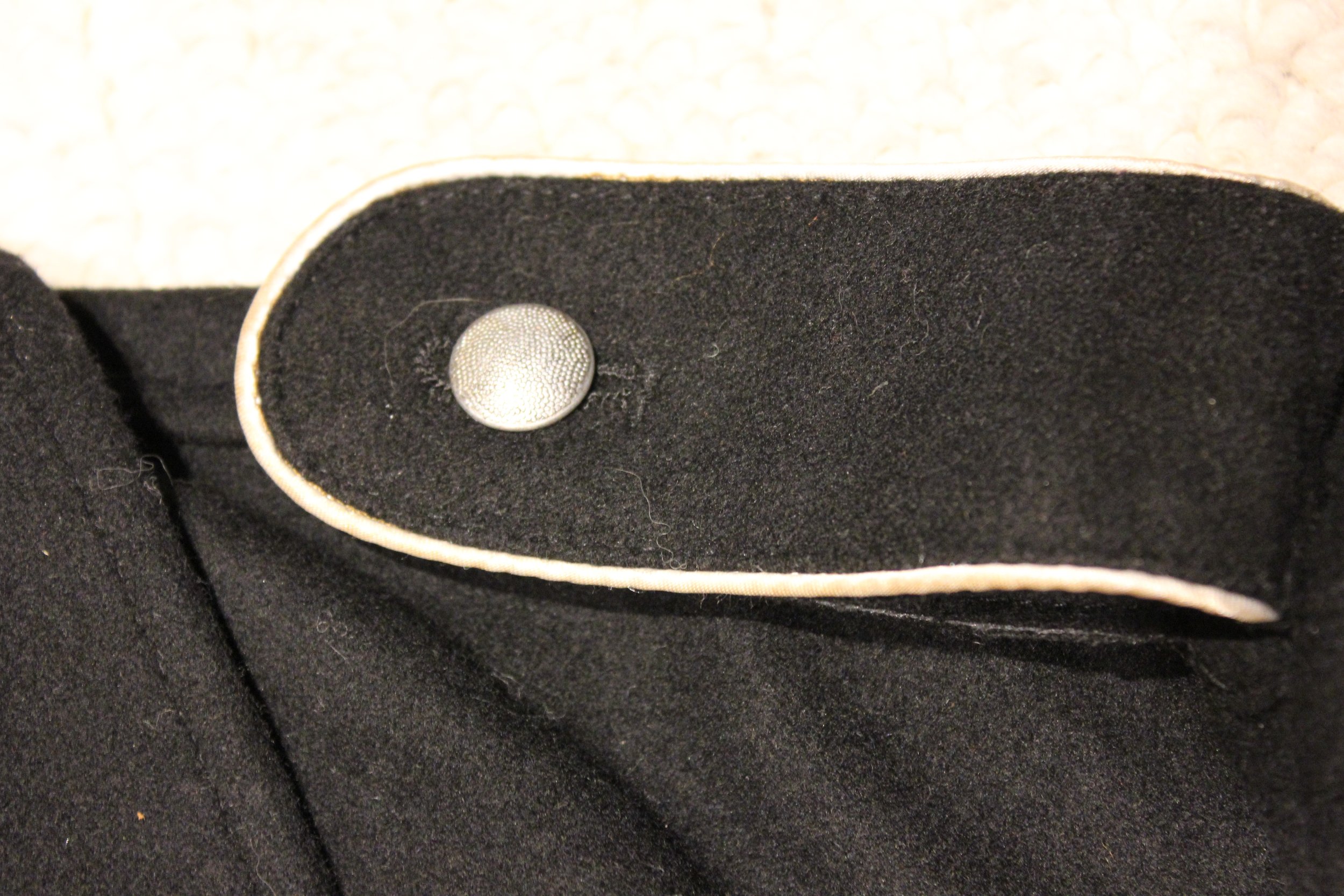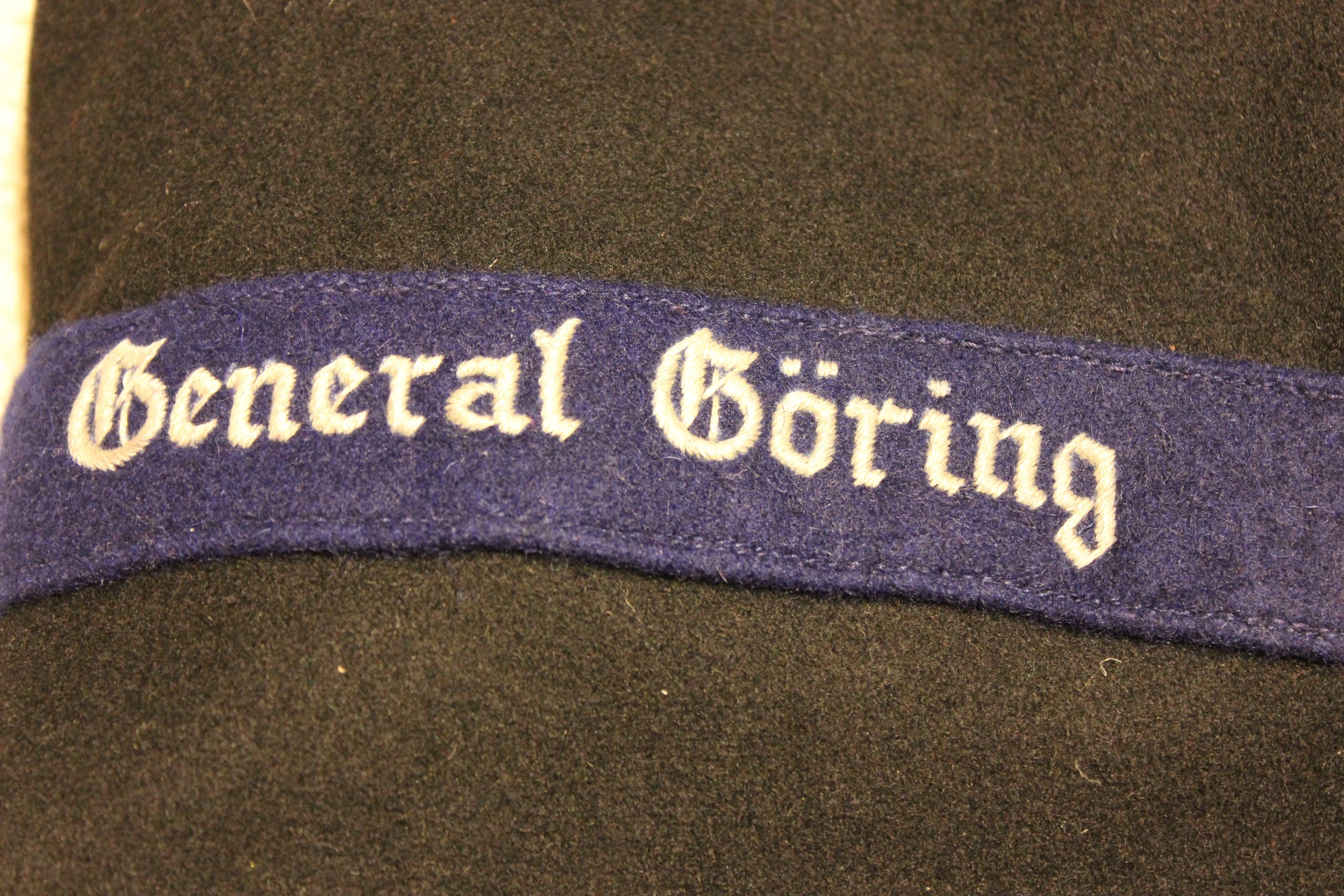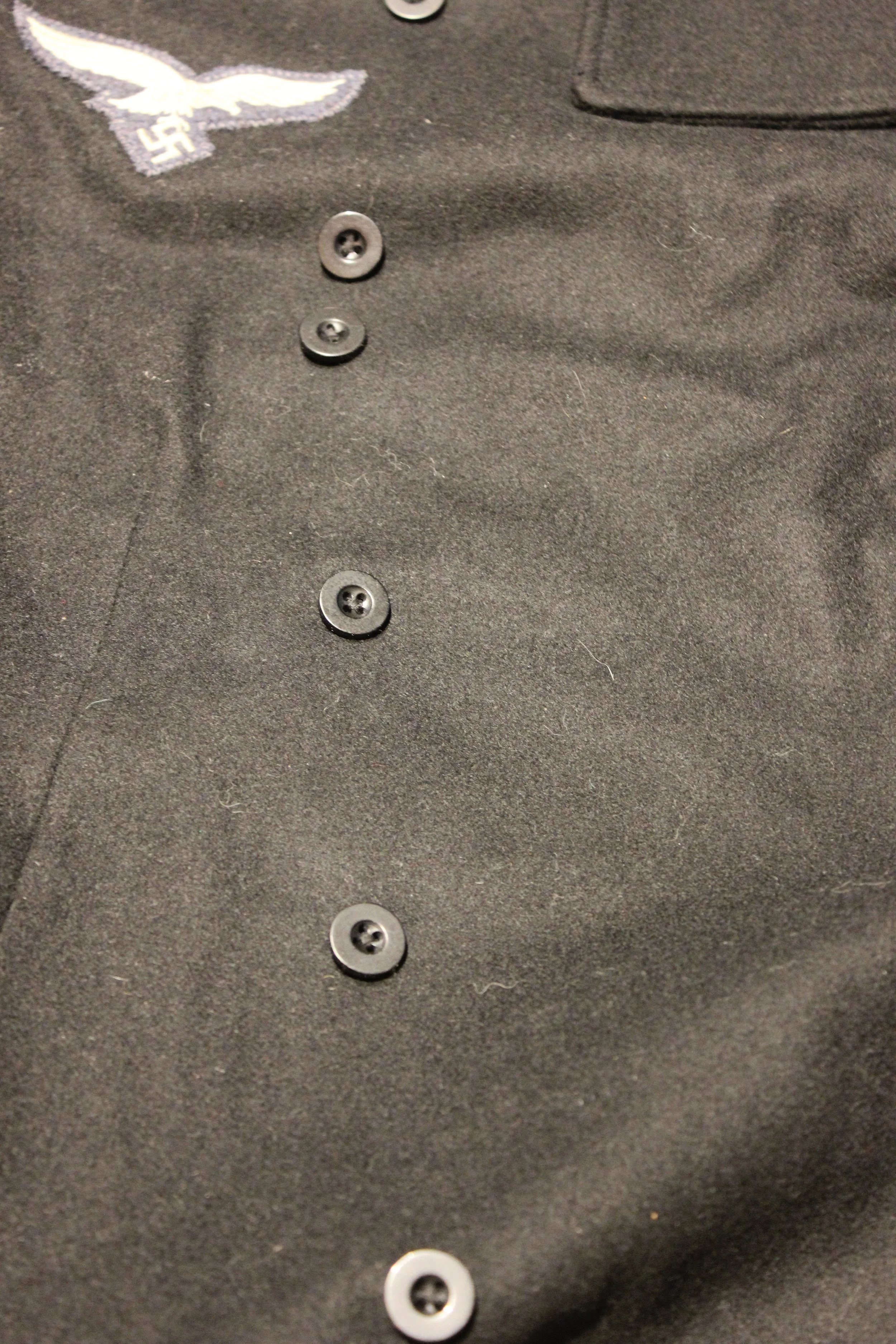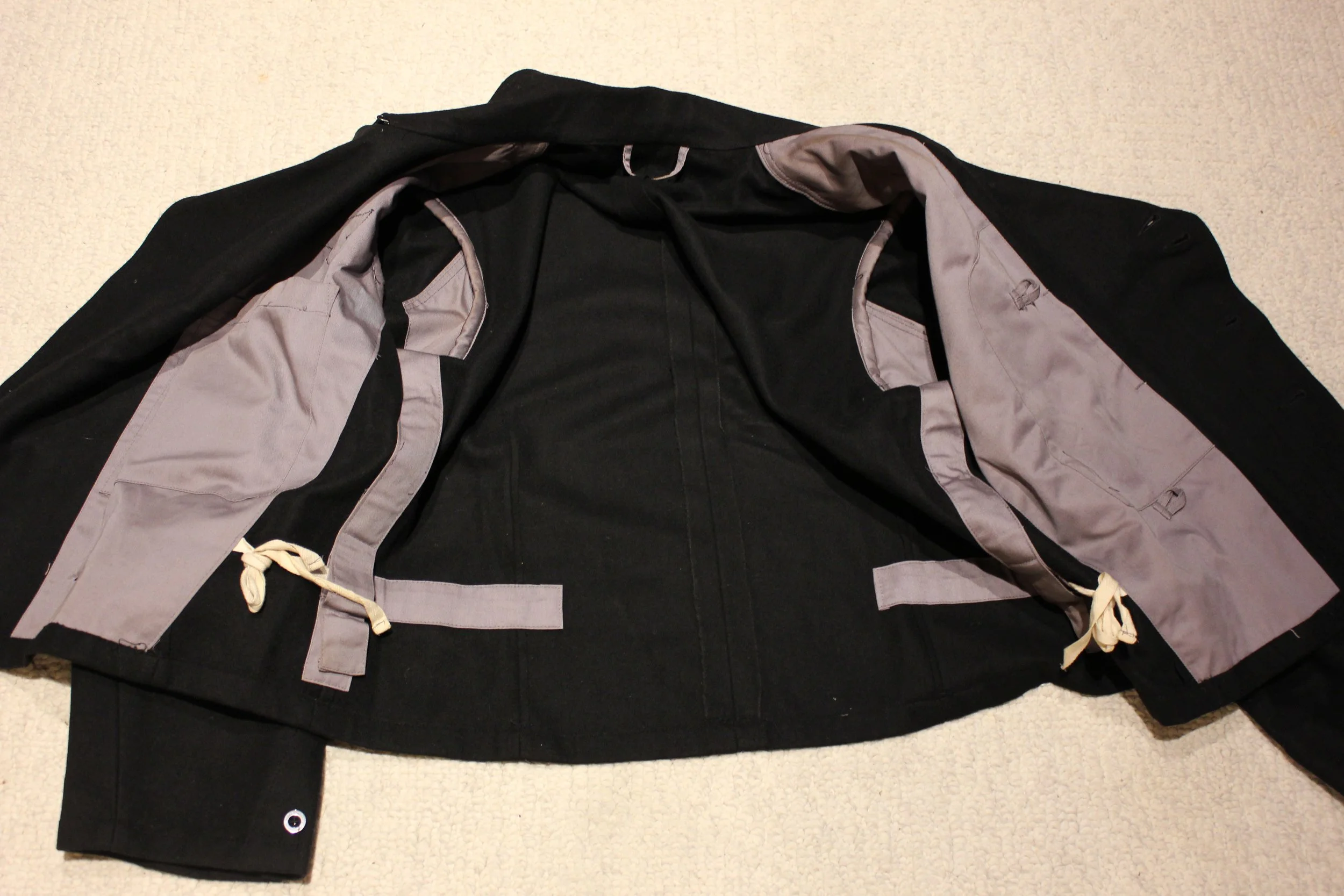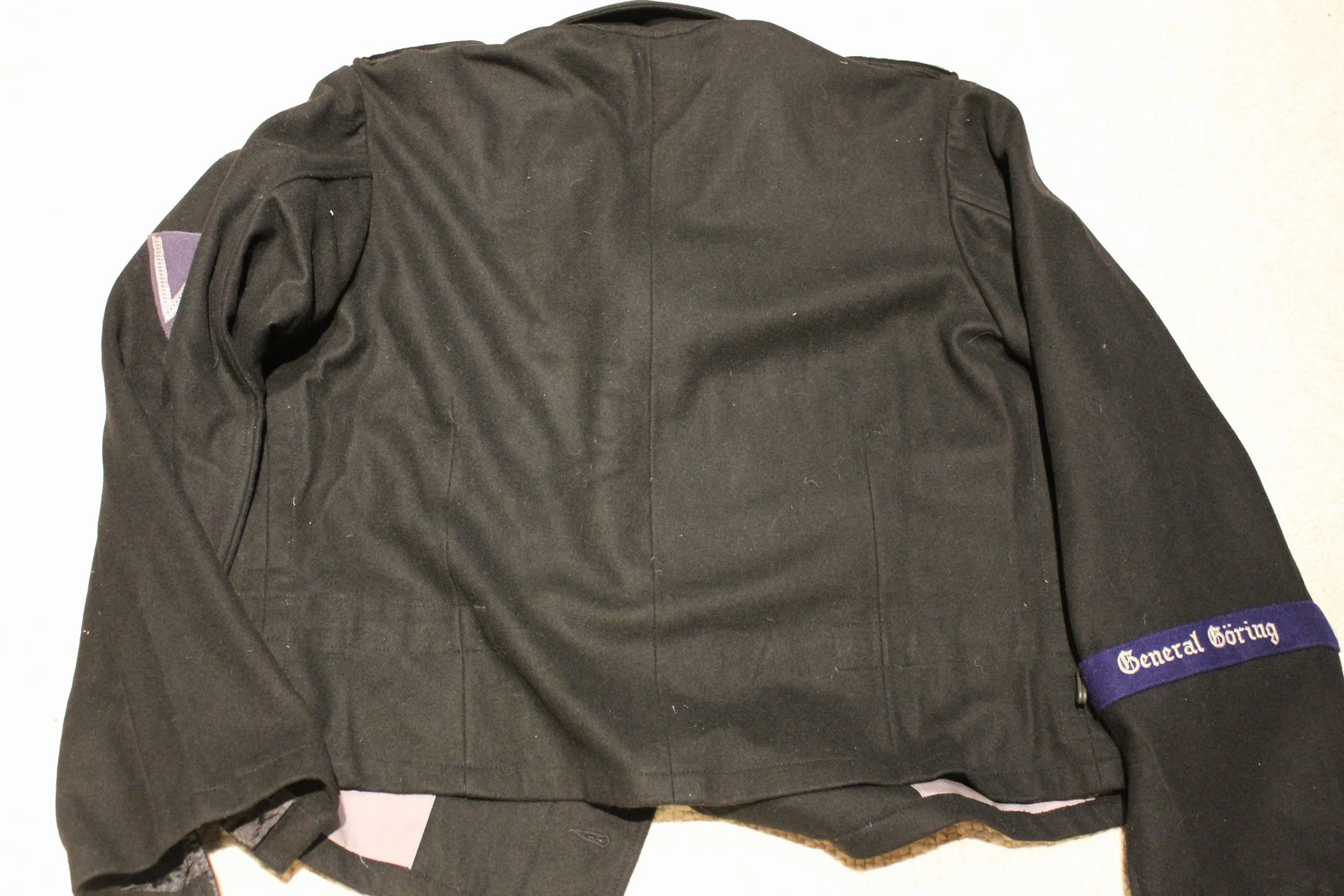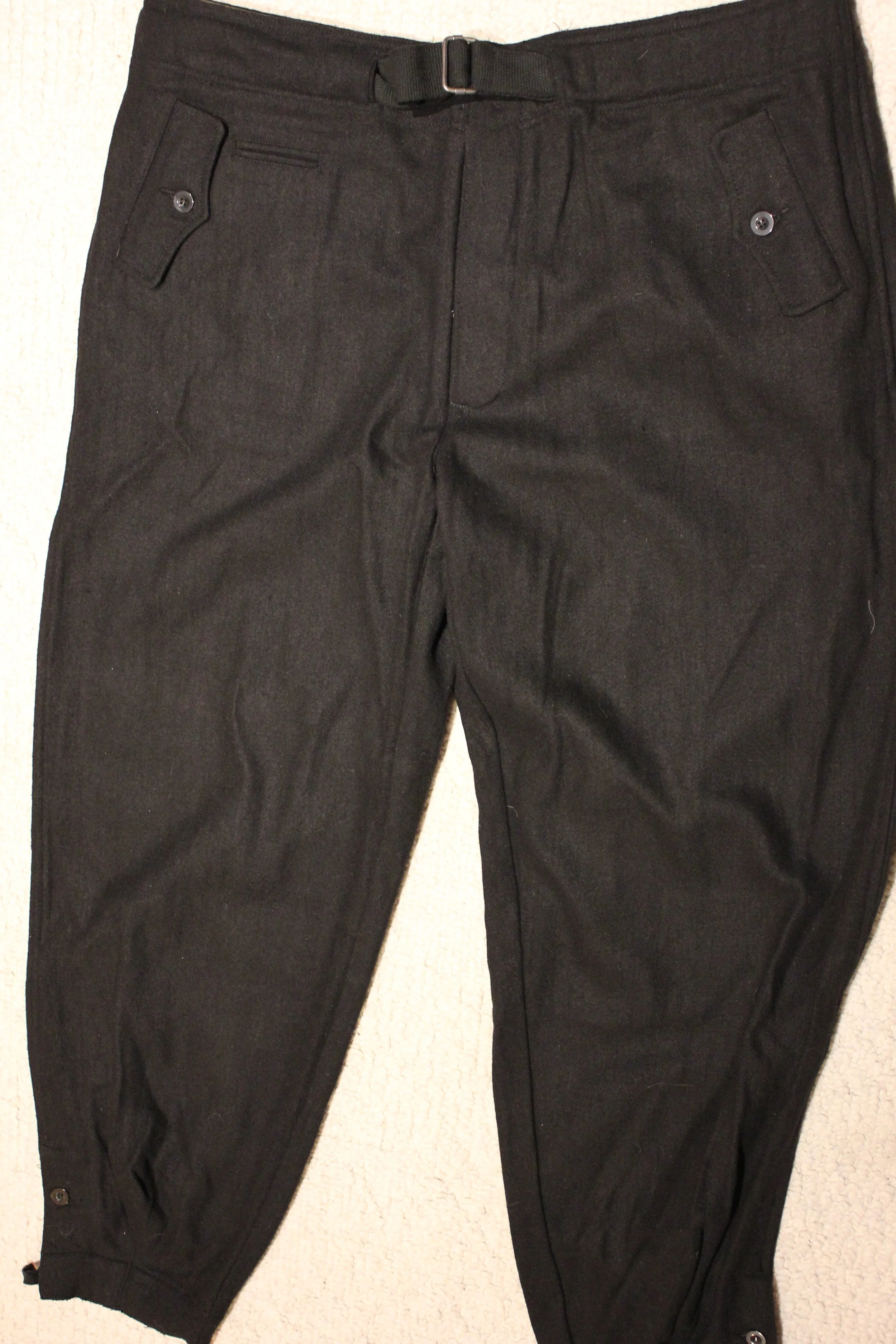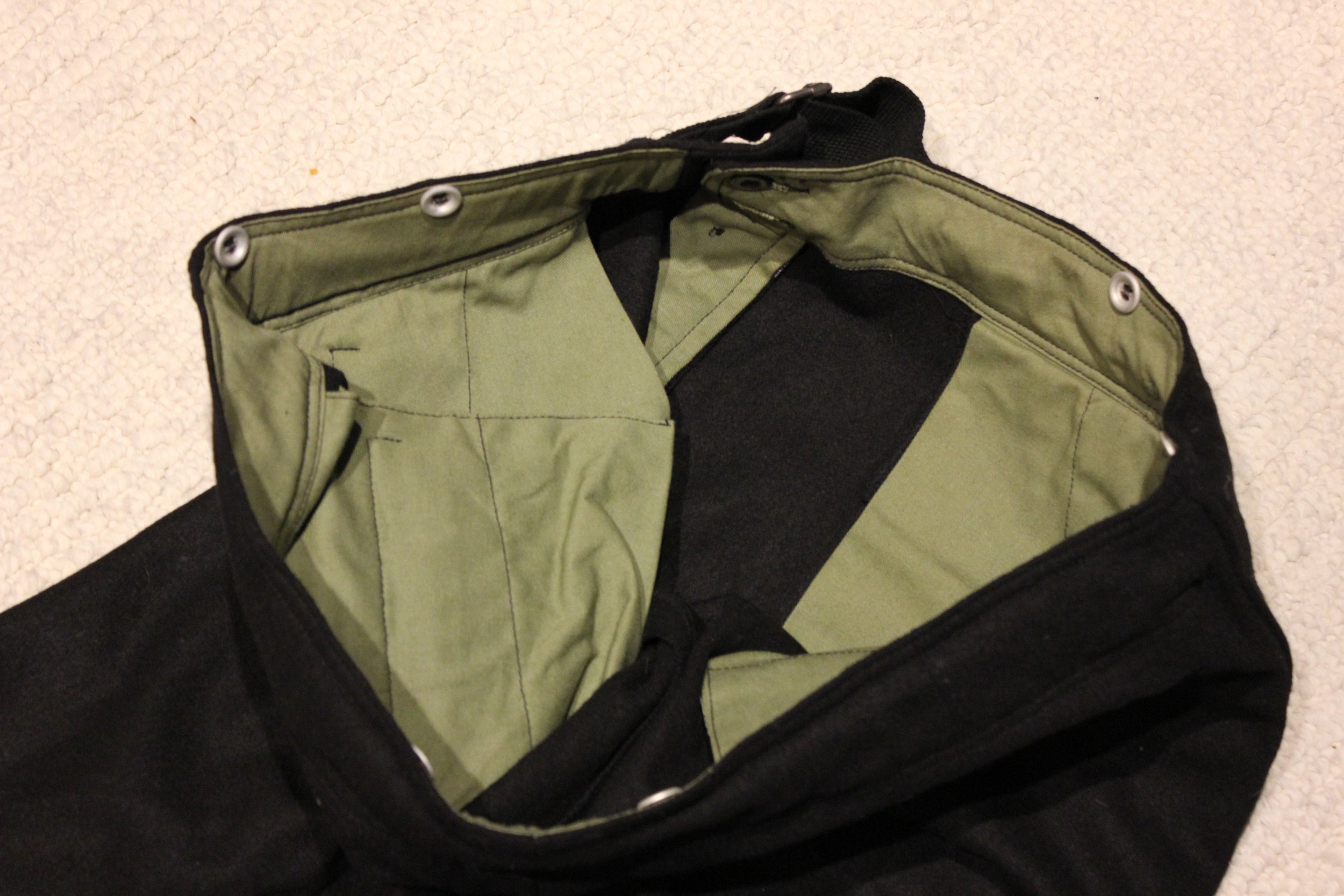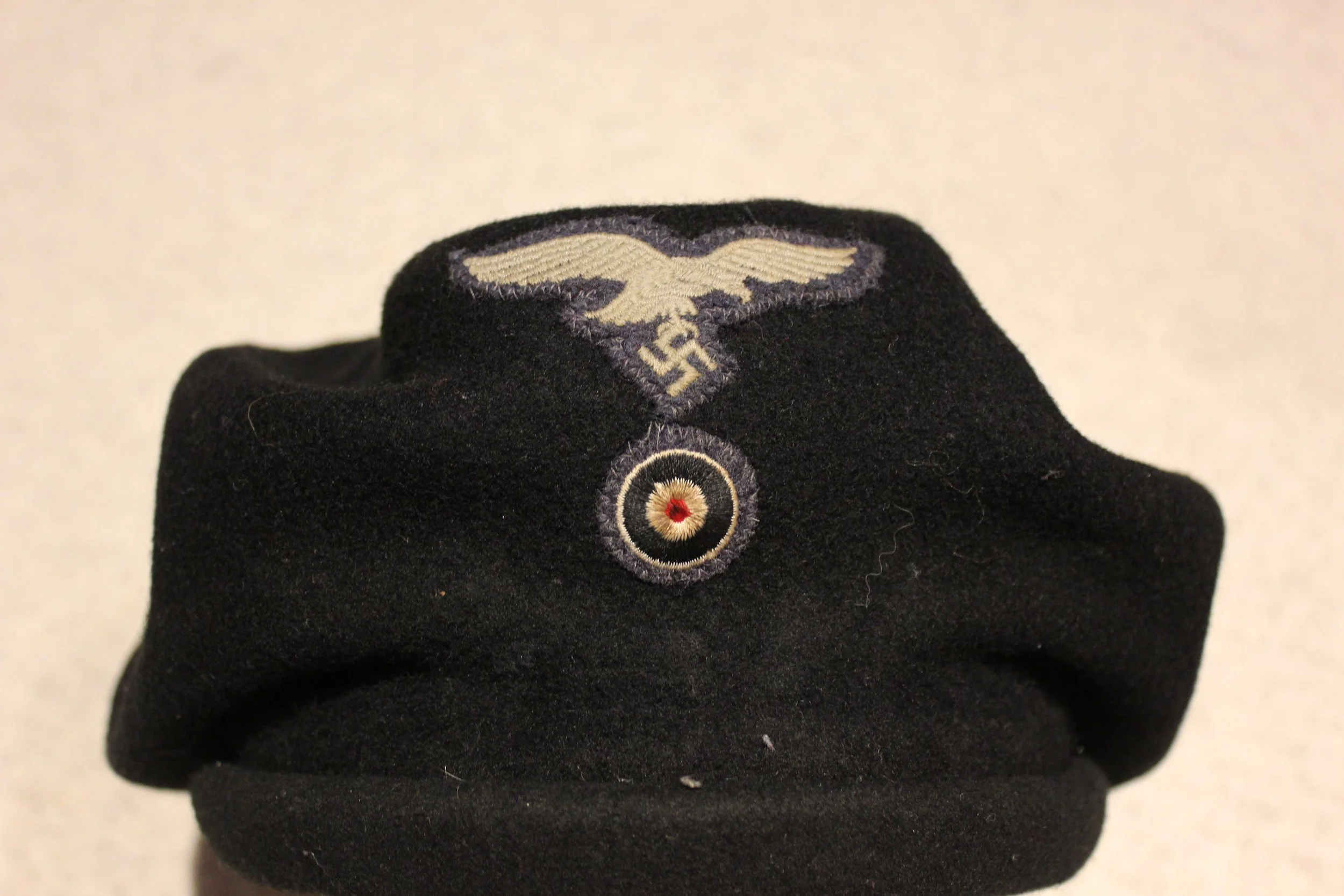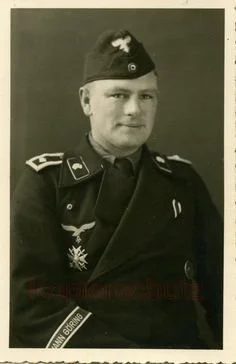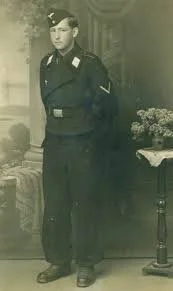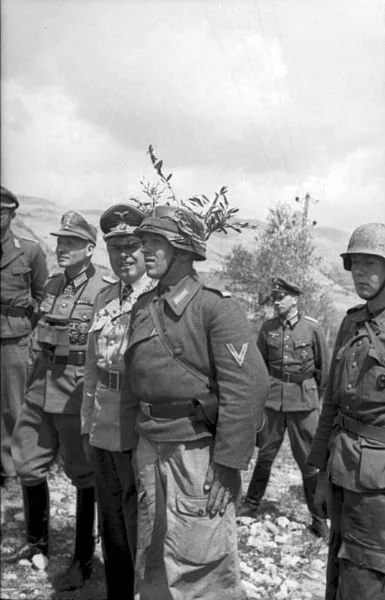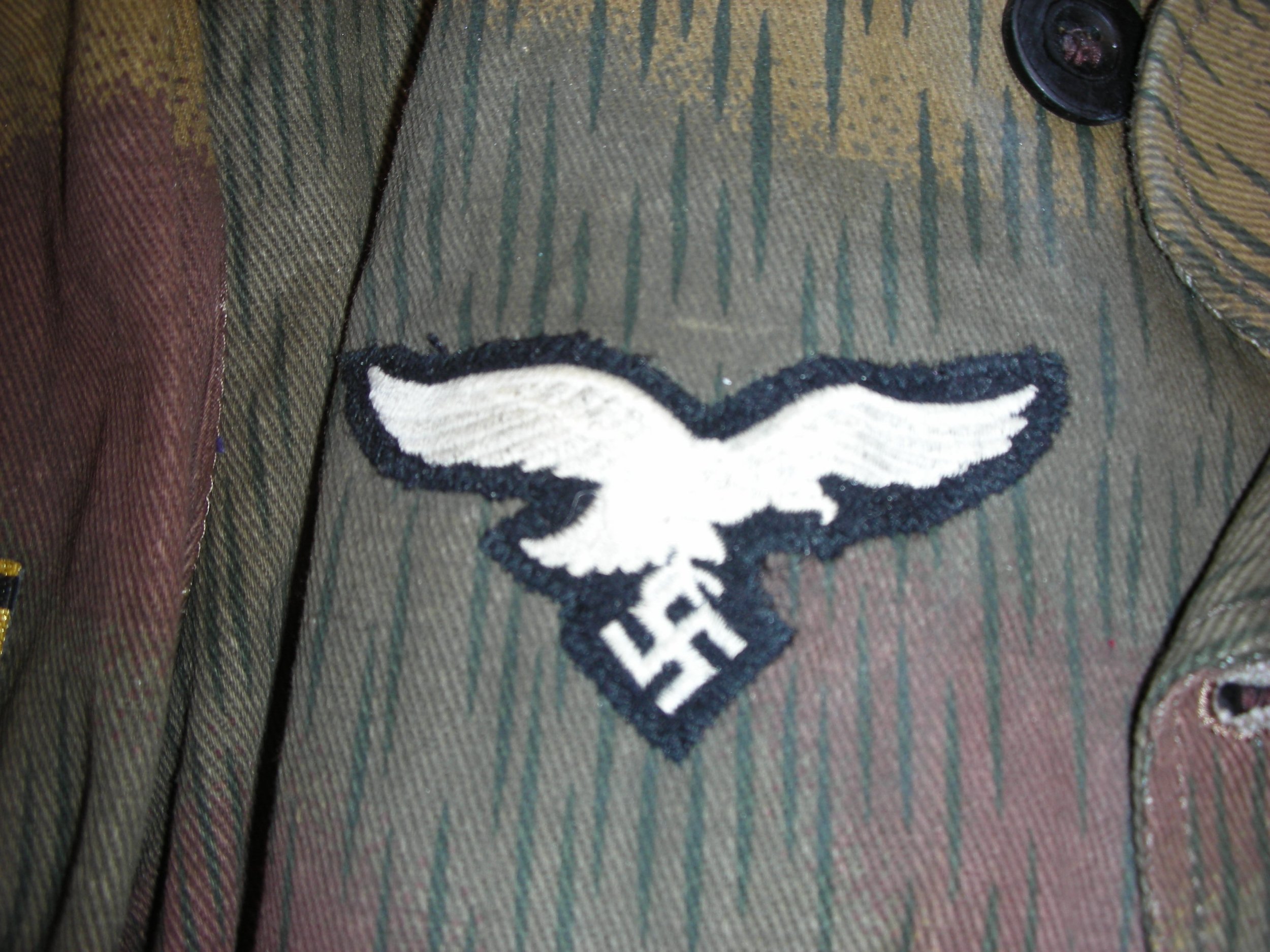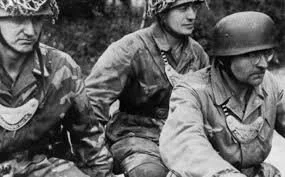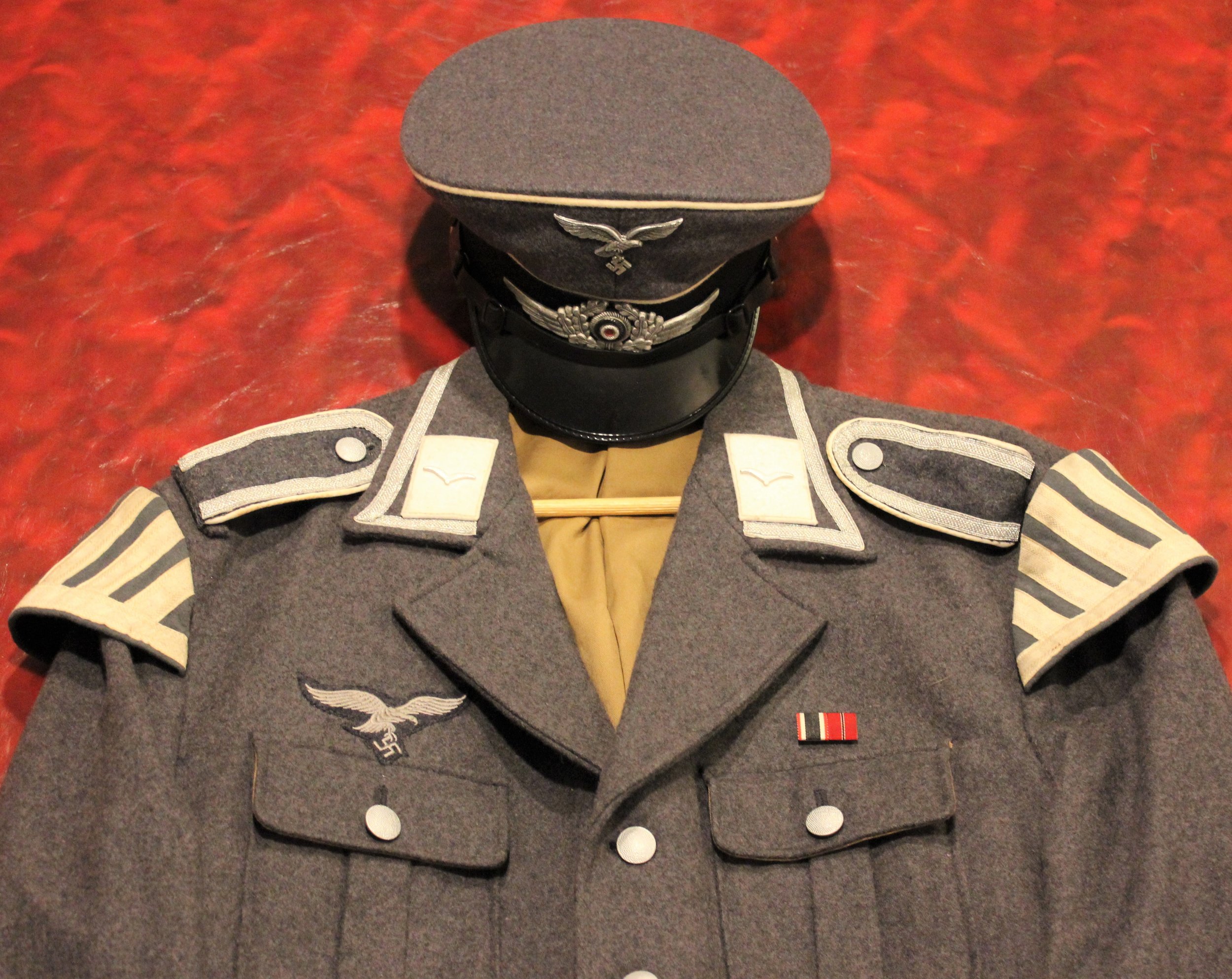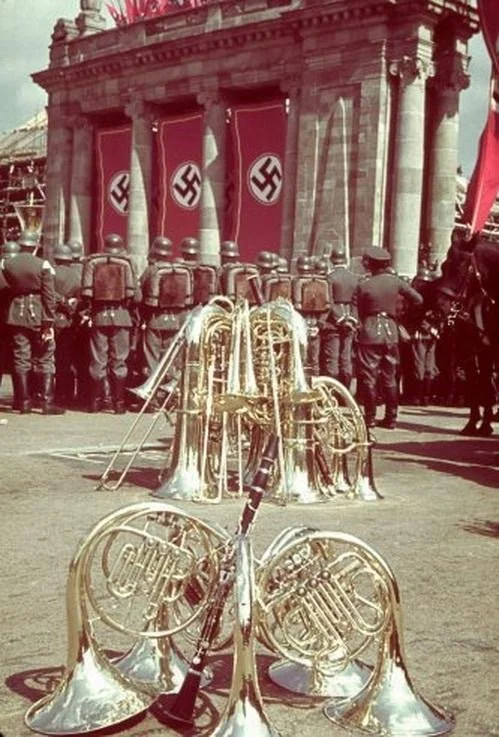Hermann Goring Division Uniforms:
Luftwaffe Jager / Rifle Regiment, Hermann Goring Division:
This Jager or Private belongs to one of the Rifle Regiments of the Hermann Goring Division. The white-collar tab insignia, a divisional identifier the Jagergurn piping the branch identifiers. The divisional cuff title is worn on the sleeve of the Fliegerbluse, which at this point of the war has become the LW uniform of choice for all personnel.
This Jager has seen action, as shown by the LW Ground Combat Badge, just newly awarded. With his Fleigerbluse, he wears standard M37 service trousers. Through the various photoshoots over the years, and this being one of the older ones in the collection, Both single and double-button / Blue-gray wool, M43 caps have been used, and these 2 are similar and should be shown here.
While in the field, he wears the LW Camouflage Field Division 4-Pocket Over-Jacket, which was created to provide the LW Aircrewmen who had become Infantry with camouflage for their LW Feldblau uniforms. The uniform had a bunch of photoshoots of it, and I have shown it with various helmets and kits as well, tall boots and ankle boots,
Note: The oddities between the uniforms, in the different pictures, are because they’re from four different photoshoots, and with each different headgear and webbing were used in, probably trousers too, as they used to be kept in boxes as hats, jackets, trousers web-gear, boots, etc, this turned out to be not the best way to do it, now its jackets with the hats, and if possible the trousers.
As for the use of Waffen-SS Smocks, it was handy, I suppose? They fought alongside their SS comrades in Italy, so there must have been a stockpile of new clothing somewhere, “Finders Keepers”. But it’s here because of the collar tabs indicating the HG Division. No idea where to give credit to, sorry, as with most period pictures, they are taken off the internet randomly to help show these uniforms.
Hermann Goring Panzer Division, Early Black Wrap, Private:
Luftwaffe Panzer Leutnant "Hermann Goring":
This Lieutenant has just rejoined the Panzer Rgt. after officer training. He has been promoted through the ranks and still maintains his NCO visor cap with officer grade insignia applied as a "crusher."
He is a veteran and wears the standard issue Panzer uniform in the Heer cut, with LW insignia applied. The white Waffenfarbe is worn only by the HG Division, which is also authorized a cuff title, this being the final pattern of the Hermann Goring Division in Latin lettering and is of officer quality. Probably joining the LW after the war began, he is representing the period around 1944.
He has been awarded both the Iron Cross I & II classes for demonstrating leadership in combat. He has won the Luftwaffe Tank Assault Badge and the Black Wound Badge. With his tunic, he wears the standard Panzer trousers with either lace-up or marching boots. Underneath, he wears a standard LW shirt, which is worn with a tie or with a Knight's Cross, which he may well win before the end of the conflict.
The shirt has an officer-quality eagle attached and, with the addition of shoulder boards and medal loops, can be used, when permitted, as an outer garment. (Note: The Knights Cross was not in the photo shoot). The fellows in the period photos wear dark gray or black shirts under their Panzer Jackets, whereas in our photoshoot, a gray scarf is worn over the shirt.
Oberfeldwebel, II./ Fallschirm-Panzer Regiment “Hermann Göring” Fallschirm-Panzer-Division 1. “Hermann Göring” 1943:
Fallschirm-Panzer-Division “Hermann Göring” has a lineage in the Landspolizeigruppe Wecke z.b.V. which was a special purpose state police group under Göring’s command in 1933. In 1935, Göring was promoted to command of the Luftwaffe and ordered the unit transferred to the Luftwaffe, renaming it Regiment General Göring in September 1935.
Two sub-units were separated from the regiment in March 1938 and redesignated as the Fallschirmjäger Division. In 1936, the regiment was assigned as Göring's bodyguards and as flak protection for Hitler's Headquarters. The regiment participated in the Anschluss and the Occupation of Czechoslovakia. During Fall Gel,b it took part in the invasion of the Netherlands and Belgium. During Operation Barbarossa, the regiment was attached to the 11. Panzer-Division, a part of Army Group South.
The regiment saw action around the areas of Radziechów, Kyiv, and Bryansk. In July 1942, the regiment was upgraded to brigade status, and then to a full Panzer division in October 1942. While the division was in formation, the Second Battle of El Alamein forced Field Marshal Erwin Rommel's Afrika Korps to retreat to Tunisia. The division was sent to Tunisia piecemeal, where it eventually surrendered with the rest of Panzer Armee Afrika.
The reformed division was designated Fallschirm-Panzer-Division “Hermann Göring” and sent to Sicily. After the Allied invasion of Sicily was launched on 10 July 1943, the division was engaged at Gela and Centuripe, retreating to Messina afterward, and then to southern Italy.
When the armistice between Italy and the Allied armed forces was signed, the division took part in Operation Achse to disarm Italian troops. The division participated in the fighting following the Allied landing at Salerno in Operation Avalanche on 9 September. It then retreated towards the Volturno–Termoli line, and then to the Gustav Line, where it was pulled out of the line for rest and refit.
The Oberfeldwebel, who is probably acting as a platoon commander, has an interesting mix of tropical and continental insignia placed on the second pattern Luftwaffe tropical Bluse. He wears the special Luftwaffe Tropenfeldmütz issued to the original units that arrived in Africa to bolster the “Deutsches Afrika Korps”. Both styles of cap insignia are shown in this period photo.
The NCO has copper-brown tropical tress sewn onto his first pattern Bluse. H.G. armor in Sicily or Southern Italy. The enlisted version of the divisional cuff title is worn with continental panzer Leitzen pipped with white Waffenfarben. Below is another example of the standard tropical cap insignia worn on the Feldmütz, in addition to the addition of the officer’s chin cord. An option might be a “Luftwaffe - tropical tan” Overseas Cap, or an M40-billed cap might have been worn, even a continental Black Panzer-Overseas Cap might have been seen in the Desert.
NCO, Hermann Goring PZ. DIV. Panzer Wrap with White Tabs:
I need to pull this out of storage and re-shoot some pictures of it.
Unterfelfwebel, Hermann Goring Division. (EM) Mouse-Gray Panzer Wrap:
This is a good example of the “Mouse Grey” Luftwaffe Panzer-Wrap, in a lightweight linen-type material. it carries odd collar insignia, in the way he has added the “Panzer-Totenkopf” to the white HG collar Tabs holding his rank. It carries the standard wool-backed-sewn-on Luftwaffe National Insignia, on the Right breast, and his Blackcap.
The uniform was seen in use with the Heer-Wehrmacht as well, and the Famous Panzer Commander Otto Carius I believe wore one in action with the Tiger I Tank.
The shoulder boards are of wool material as well. The uniform came as is, with a cap, jacket belt, and trousers, it is by far the most expensive in the collection and I won it on a bid, thinking it was less money? than it was, I did not get the paperwork, and that was a big mistake, but love the uniform.
Leutnant, Hermann Goring Division. Dress Uniform:
Hermann Göring Sturmgeschütz Battalion Officer in Grey Wrap:
Hermann Goring, StuG. Crewman in Feldgrau:
Well…not find his uniform’s story. but this I can tell you, the Feldgrau uniform would be the standard color for the Heer and Waffen-SS, so why not adopt it here, it was likely a handy fix for the “Assault Artillry Troop” and perhaps a bit warm for Italy, but then ., They fought, backing up into hills where it was much cooler.
Trained in Artillery, he has his shooting award on the right shoulder, which should have been hanging from a hidden button under the shoulder board; however, this is a battlefield uniform, and they were rarely seen on them.
He has the Artillery Battle Badge and Wound Badge. The uniform has had several caps, along with the Feldgrau one, but this seems to be the one applied here now.
Gefreiter, Panzerregiment “Hermann Göring” Italy, 1944:
Following the surrender of the Panzer Division “Hermann Göring” with the remnants of the Afrika Korps, a new division was reformed under the same name and sent to Sicily. The allies invaded in July of 1943, and most of the Italian units quickly surrendered and the division was one of the few reliable formations that remained.
It fought at Gela and Priolo, but it was forced back due to the naval bombardment. It continued fighting a defensive battle while the German forces were evacuated from Sicily during Operation Lehrgang and were among the last units to leave Sicily.
It was stationed near Naples when the Italian government surrendered to the Allies, and it was used to disarm the Italian troops in the Salerno area. The allies landed at Salerno in early September, and the division engaged in a fighting withdrawal from Salerno and later from Naples and the Volturno-Termoli Line in October. It retreated with the rest of the German troops to the Gustav Line and was removed from the front lines where it was replaced by infantry troops.
Troops, led by Oberstleutnant Julius Schlegel, moved the treasures of the Monte Cassino Monastery including paintings by da Vinci, Titian, Raphael, & others along with the remains of St. Benedict, 70,000 historical books, and 1,200 documents to safety in the Vatican, thus saving them from destruction during the Battle of Monte Cassino. Schlegel was to spend seven months in Allied prisons after the war as a suspected looter and war criminal before being freed by Field Marshal Alexander and the testimony of the Monte Cassino monks.
When the Allies landed at Anzio in January 1944, the division was rushed from the Gustav Line to hold the Americans on the beachhead. It fought ferociously at Cistern, and the Germans managed to fight the Allies to a virtual standstill.
The corps size Fallschirm-Panzerkorps Hermann Göring was created in 1944 by combining the unit with the Fallschirm-Panzergrenadier Division 2 “Hermann Göring”. With the start of Operation Diadem in mid-May, the division retreated toward Rome and abandoned the city. Eventually withdrawn from Italy, the division fought the remainder of the war on the Eastern Front.
A Waffen-SS reed-green Herringbone Cotton-Twill warm weather Panzerjacke is worn along with standard Luftwaffe tropical Hemd u. Operation Diadem in mid-May, the division retreated towards Rome and then abandoned the city. Eventually withdrawn from Italy, the division fought the remainder of the war on the Eastern Front.
A Waffen-SS reed-green Herringbone Twill warm weather Panzerjacke is worn along with standard Luftwaffe tropical Hemd u. Hosen. The Gefreiter has applied divisional Panzer insignia with white waffenfarbe and has both the Luftwaffe Einheitsfeldmütz für Panzertruppen as well as the Tropenfeldmütz Model 1941 (Tan-Cap). Note: This Tan-Cap would also have fit well with the “Oberfeldwebel”, II./ Fallschirm-Panzer Regiment “Hermann Göring” Tan-Tunic ( in the HG-Panzer Crewman in the collection).
Hauptman 1. Hermann Goring Panzer Artillery Rgt. Italy 1944:
The Hermann Goring Parachute Panzer Division was first formed as a regiment in France in 1942. The division accepted only German volunteers; no foreigners or Volksdeutsche were admitted.
The division saw action in Tunisia, Sicily, Italy, and the Eastern Front before it ended the war in East Prussia. A man of long combat experience, this Hauptman wears a Tan & Water SS cut armored jacket. HG was known to wear SS-issue camouflage and this jacket appears to have been either a special production using the fabric from either FJ or Field Division uniforms or custom-tailored production.
There is an interesting mix of officer quality and enlisted insignia, perhaps explained by the use of a collar and shoulder insignia salvaged from a previous uniform, mixed with available enlisted grade items. If the jacket was indeed a production model designed for tank crewmen, then the black-backed eagle is totally in place. Interestingly, he wears an enlisted crusher cap, perhaps in place of an M43 cap.
Instead of standard armored trousers, he wears standard FJ trousers. We see that this officer has seen combat in Africa and has probably served on every front the division has been sent to. He has won both the Iron Cross I and II for combat leadership. He has been wounded at least once or maybe up to three times.
He has won the Luftwaffe Ground Combat Badge, which, given service, is due for an upgrade to one for more engagements. He has survived the single-handed engagement of enemy tanks, destroying at least five as shown by the rare Gold Tank Destruction Badge on his right sleeve.
Der Spiess, Hermann Goring Flak Regiment:
Hauptmann, Feldgendarmerie, Luftwaffe Fallschirmpanzerdivision “Hermann Goring”:
The 1st Parachute Panzer Division “Hermann Goring” was an all-volunteer Luftwaffe unit that accepted no foreign or Volksdeutsche Volunteers. Elements of the division were sent to Tunisia in early 1943 and were destroyed with Army Group Afrika.
In preparation to move to Africa, the rest of the division was sent to Italy. and from there to defend Sicily. Reconstituted in Italy, the division fought in all the major battles on the Italian Front until the fall of Rome. When it was sent to the Eastern Front where it halted the Soviet drive north of Warsaw. The Division fought on the Russian front until the end of the war.
This Hauptman is a ranking officer in the Feldgendarmarie at a corps level By the end of the war. The uniform displays both the Corps Cuff Title and the standard Feldgendarmerie Cuff Title on his tunic. He wears a Model 43 enlisted tunic, which has been modified for officer use with the addition of an aluminum collar cord and officer insignia.
Hermann Goring Division had been working directly alongside Waffen SS units in Italy and Russia and was one of the few non-SS units to use Waffen-SS camouflage pattern uniforms, such as smocks and 4-pocket jackets, as well as caps and helmet covers. Interestingly, this Hauptmann has used SS-Feldgendarmerie shoulder boards in place of the white piped HG Officers’ boards.
The ribbon bar shows us he has been in combat since at least 1941, as he has been awarded the Ost Front / Winter medal. He has at least 12 years in service as well, his time in action is identified by his Luftwaffe Ground Combat Badge (with 25 days in combat).
He has been awarded the Iron Cross I and II for combat leadership and has been wounded at least 3 times. He wears a standard Luftwaffe officer cap and has a helmet as well. Standard LW trousers and low boots with gamaschen are worn along with an officer belt, pistol and holster, and other equipment. When on duty, he would have worn the Feldgendarmerie Gorget, and the uniform had one with it, I forgot it on the photoshoot..
Gefreiter, Felgendarmerie, Luftwaffe Fallschirmpanzerdivision “Hermann Goring”:
If you haven’t gotten the story of the HG. Division from the other uniforms in the section, I’ll repeat, the 1st Parachute Panzer Division “Hermann Goring” was an all-volunteer Luftwaffe unit, that was ‘All-German’ using no Foreign or Volksdeutsche in their ranks.
The “Parachute” designation was only honorary. Formed as a regiment in France, it expanded to brigade size in 1942, then again expanded into a divisional size in Belgium in 1943. Elements of the division were sent to Tunisia in early 1943 only to get destroyed by Army Group Africa.
In preparation to move to Africa the rest of the division was sent to Italy and from there to defend Sicily. Being reconstituted in Italy the division fought in all the major battles there, up to when Rome fell. When it was sent to the Eastern Front, like many units sent to stem the tide, it was made up of some experienced soldiers, made officers and NCOs filling the ranks with many inexperienced enlisted volunteers, they did fight the best they could with what they had, but the end was inevitable, still, they fought there till the end.
I wanted to show the use of Heer-Wehrmacht uniform material here. He may have been a prior Heer Feldgendarmerie or, it was likely that the uniform was available when he needed a replacement. what-ever the case, It’s believed he would have been part of the build-up to Korps level, in the rushed Heer uniforms might have been used.
While he is still with a low rank, he has seen action with the ground elements of “HG” and applied his Luftwaffe Rank, and shoulder boards, with the Luftwaffe National Eagle to the jacket (Having removed the Heer pattern Eagle) but kept it basic and simple.
He may have used Heer trousers or Luftwaffe blue/gray just as well. Wearing the divisional title on his Right sleeve, he has the universal Feldgendarmere cuff title applied to the Left sleeve too.
The late war (M-44) “Heer-Stock” jacket would have used the short leather ankle boots with leggings over them, with either black or brown issued belt, and holster, and the ever-present Gorget (here again, more often than not, the Heer type was used). He likely would have worn a Luftwaffe blue shirt with the uniform, but Heer and SS stock was likely used in Italy, as it was a supply situation where little was available.
Unteroffizier, Spielleute des Regiment “General Goring”:
In 1835, almost immediately after its inception, the training arm of the Luftwaffe’s Musik Korps was keen to announce its arrival on the Military Music Scene.
And they introduced a very distinctive style of symphonic brass music, to emphasize this newest, youngest, and most special arm of the Luftwaffe, and the newly appointed Luftwaffenmusikinspizient (Director of Music) Professor Hans Felix Husadel was to be the driving force and a very great musical reformer & German Air Force ‘Musical Visionary’.
In 1935 it was Husadel who introduced the Saxophone to the Luftwaffes music inventory, breaking a long-held boycott of this, supposedly, a “Negro Instrument”, along with a full line of Clarinets and Brass Trumpets & Alto-Slide Trombone; in addition, the much beloved traditionary rotary valves were replaced by pump valves.
Professor Husadel also ordered the openings of the higher-pitched instruments to be narrowed so as to gain a greater sharpness & clarity of sound.
He also engaged composers to write music specifically for the new arm, including Erwin Dressel & Bruno Stein, who developed a modern style of military band music, more akin to the British and American Sousa than the traditional Prusso-German marches.
With an ongoing lack of written scores being reported as “a serious shortcoming in the field of brass music” in the 1938/39 annual report of the Reichsverband fur Volksmusik (National Folk Music Association), Prof. Husadel introduced his own compositions, including Fligerfanfare and the Marches Geschwader Horst Wessel and Kampfgeschwader Richtofen.
He also introduced the new silver-plated look of the instruments to replace the standard brass finish, thereby ensuring a new modern look and sound for the German Luftwaffe’s military bands, guaranteed success, and was fundamental in promoting a real feeling of Elitism and pride in the newest arm of the Third Reich.
The Luftwaffe regiments and Geschwader paraded both a Musikkorps and a fife and drum Spieleute and regimental battalions only operated a band when stationed in Garrison Towns, and then only a small band, to ensure compliance with the regulations that each garrison was to be musically represented to some degree.
All Luftwaffe regiments and Geschwader paraded both Musikkorps and Spielleute came under the unit’s regimental headquarters and differed in size and instrumentation, depending on the intended role.
The Musikkorps of the elite General Goring Regiment was the largest of the German Air Force Bands, which by the outbreak of the war in 1939, comprised some 60 NCOs and airmen, assisted by a large Spielmannszug comprising 48 NCOs and airmen. Next in terms of manpower was the staff band of the Reichs Air Ministry (Stabsmusikkorps des Reichsluftministeriums), with 54 NCOs and airmen and a Spielmannszug 16 strong.
As the Wehrmacht rapidly increased after mobilization, not all Musikkorps were able, to field full-strength bands, and in some instances, where a Luftwaffe officer was unable to lead as Musikmeister, senior NCOs took over the role in the designation as Korpsfuhrer.
It was common for military musicians to transfer between branches of service as shortages of specialist musicians (or advertised vacancies), became evident and so Army musicians were often drafted into the Luftwaffe and vice versa.
As part of Prof. Husadel’s modernization program, Hitler’s new arm was most keen to take full advantage of the great advancements taking place inside the Third Reich's recording industry. Thus, the Luftwaffe was amongst the most prolific of the Wehrmacht’s Musikkorps to record on shellac 78 rpm and can be seen on more record labels than perhaps any other, especially Musikkorps der Fliegerhorst Kommander Kommandantur Berlin-Staaken. Musikkorps der Flak-Artillie and of course Musikkorps des Regts. General Goring.
This Unteroffizier uniform was shown in 1942. The Regiment took part in the invasion of Russia and has been awarded the Ost Front Medal. His performance in the Speilte has been noted with the award of the War Merit Cross without Swords. Spielleute's duty is shown by the non-fringed “Swallow’s Nests” or musician’s wings placed on the blues’ shoulders during a performance.
The performance uniform consists of the Stahlhelm, issue Shirt, Tie, Bluse, and trousers bloused into highly shined Marching Boots. Drummers made use of Y-straps to support the Cartridge Belt, which in turn supports the drum equipment.
Generalleutnant Fallschirm-Panzer Division ,,Hermann Goring”:
Tailor-made from a Waffen-SS camouflage four-pocket Dienstbluse, this senior officer’s Model 1944 patterned jacket replaced the top section of buttons with a zip-fastener. The sleeve rank insignia system used gold-yellow on black for general grade and this was worn by a member of the Fallschirm-Panzer Division H.G.
Heer and Waffen-SS pattern style has been used. A gold-yellow thread eagle has been applied; it, too, has the black backing of Panzer insignia. Issued in November of 1944, the Panzerkampfabzeichen der Luftwaffe is appropriate, as is the Fallschirmjäger qualification badge for this divisional leader. A standard Heer enlisted tropical Feldmütz has been slightly altered with the Luftwaffe eagle and bullion cockade.
The theater-made Model 44 Bluse had precedence in the Luftwaffe in Italy, with units creating them from Italian fabric. Recently discovered period photos and advanced private collections have shown the use of the trendy camouflage uniform cut in lightweight field uniforms.











